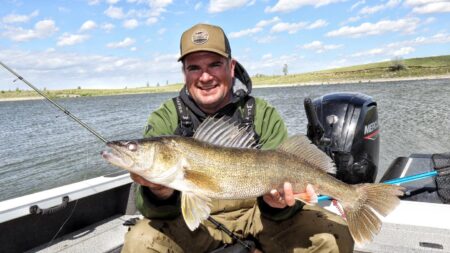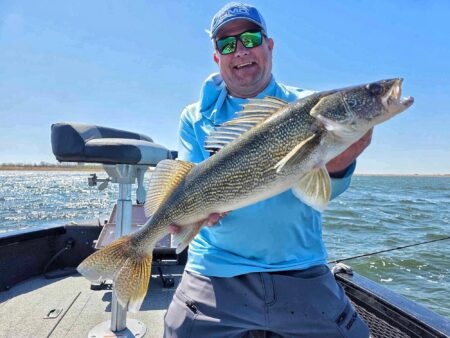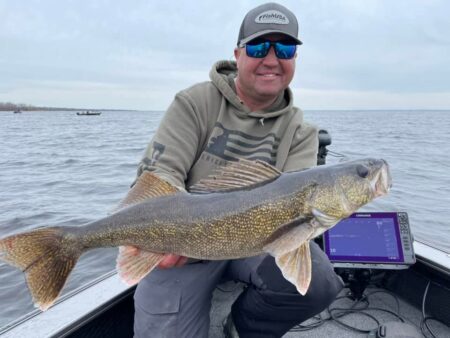There’s never been a time more exciting in fishing history with all of the technology available to be a more successful angler, whether that’s Lowrance, Humminbird, or Garmin. And when it comes to forward-facing sonar, ice combos from these brands all have their pros and cons. There is no perfect system—it all depends on how and where you fish – as well as what you have your boat rigged with for economical, double-duty between open water and ice.
Another deciding factor can be your favorite mapping for where you fish: that could be Lowrance C-Map, various versions of Garmin-owned Navionics, or Humminbird’s LakeMaster VX Premium.
While our readers fall into various camps (as well as anglers using more than one manufacturer’s sonar equipment) – there are also lots of ice anglers using Vexilar, MarCum, and Humminbird flashers – either singly or in tandem with forward-facing sonar.
One of the arguments to augmenting flasher or combo graph use with any forward facing sonar is on some waters (and it can be species dependent) fish may move more often when continuously “shined” with forward facing sonar. As a result, some anglers will use forward-facing sonar simply to locate fish, shutting it off after fish are located and new holes are drilled, then fish with a regular ice ‘ducer on their FF unit, separate graph combos, or flashers—all with less powerful transducers—or at least different frequencies. But in a lot of situations the fish don’t seem to care if you’re shining them with forward facing sonar. Our advice? Play around with it where you fish and let the fish dictate your approach.
In this look at forward-facing sonar, we’re going to focus on Humminbird MEGA Live and discuss a few things you can do to optimize your unit for optimum performance during the winter months. And yes, there’s still plenty of ice fishing left!

Northern Minnesota fishing guide, Brian “Bro” Brosdahl has been using Humminbird MEGA Live since it hit the scene. We talked with Bro to find out what settings he uses to get the best possible performance out of his forward-facing sonar set-up on hardwater.
*Note: Before you change any of the default settings on your MEGA Live ice combo, make sure to update both your MEGA Live (software version 1.300) and G3 or G4 model Helix 8, 9, or 10 (software version 2.930) with the latest software available either via download onto a 32GB SD card via the Humminbird website here, or via the One-Boat Network app. Numerous improvements have been made in the latest software that greatly increase performance.

VA: When you’re out looking for walleyes, how are you using Humminbird MEGA Live in the forward setting?
BRO: I typically set the forward range to look out 70 to 80 feet—90 to 100 feet if I’m really scouring areas. At these distances, I narrow the beam to 20 degrees for locating walleyes; 40 degrees for locating panfish. Better to use a shotgun than a rifle in some situations.
VA: How are you adjusting sensitivity and contrast?
I generally play around with both sensitivity and contrast based on water clarity. I’ll increase sensitivity up to about 14. Some guys like a lot of noise in their signal to see every little thing. I dial just back from that starting to happen. Obviously, I try to spot fish from the farthest distance possible, especially in clear water situations before I run and drill holes for clients. As far as Contrast, I set that to 11—and Dynamic Contrast to “balanced”.
VA: Any advice for anglers just starting to use MEGA Live?
BRO: Using depth lines (which looks like a grid on the screen) can help you learn the size of the fish you’re seeing. And probably most importantly, I always adjust the bottom to be one foot deeper than the depth I’m fishing so it gives me the biggest possible picture on my Humminbird screen. I think a lot of anglers don’t maximize their viewing space of the water column. This makes my bait and fish larger and easier to see on the screen.
VA: Are there any specific color palettes that you like?
BRO: Amber’s a good palette because it’s easy on my eyes and it shows bright and shaded images to easily to discern fish. The fish will be white and the bottom will be slightly amber and there’s good target separation. I also like the green and red palette; I’ve been using that a lot more. It’s more of a an old-school sonar look to it and everything pops visually really well. And I really like the number 8 palette.
VA: Once you find the fish, do you vertical jig with MEGA Live in Down or Forward Mode?
BRO: When I have clients in a skid house or hub – typically about a 10 foot space – all the guys can see their lines in Down Mode. If there are more than three clients, I’ll give them an extra Mega Live unit. The cool thing about this from a guide’s perspective is now they now I’m not BS’ing them when I tell them they’re on fish; they can see them on the screen. For me, personally, I’ll alternate between down and forward mode depending on depth – and if I need to figure out what direction the fish are moving in from, which forward mode can help with – again, depending on depth.

VA: When scouting fish, will you search with MEGA Live and fish with a flasher or graph combo to avoid spooking fish?
BRO: A lot of times when you mark fish and pace off your next hole over those spotted fish, the simple act of drilling one hole will push walleyes off the spot, no matter what kind of unit you plan to fish with. A lot of times I’m investigating and investing in returning to those travel route spots or pieces of structure later on or during power hour. Fish might move off if spooked, but they’ll be back – which happens a lot on lakes like Winnie, Cass, and Leech.
With panfish it’s kind of a different deal. I’ll locate fish a good distance from my MEGA Live, go over and drill some holes, and my clients can use flashers or a HELIX 7 or whatever. Sometimes schools of crappies will move the more you use forward-facing sonar and you have to follow them every so often, but for the most part you can just keep fishing them with MEGA Live or whatever you’ve got. It really varies lake to lake and how much panfish are getting pushed around by anglers with these new technologies.




